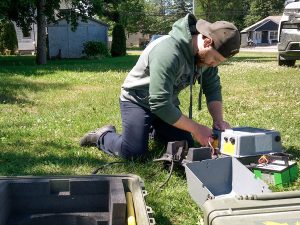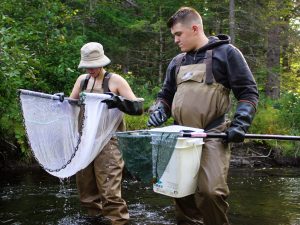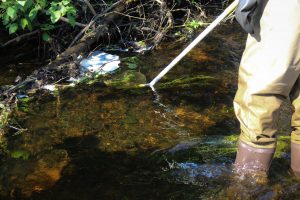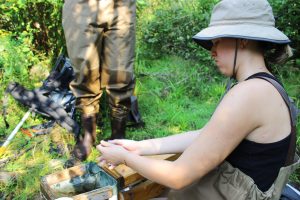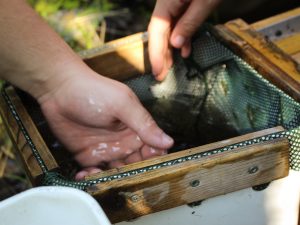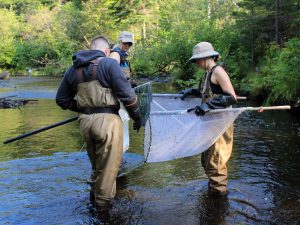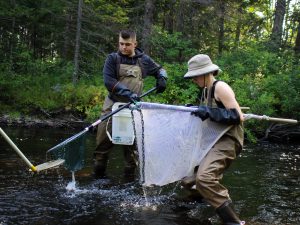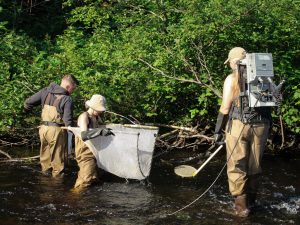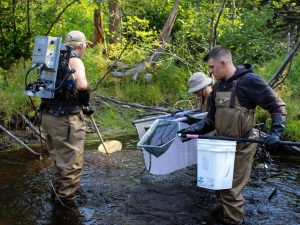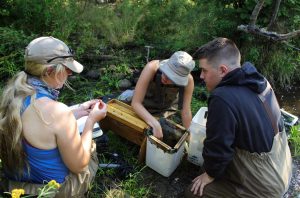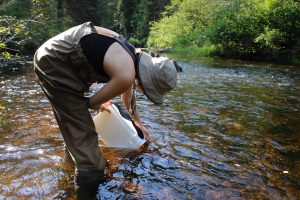Electrofishing is a common method of surveying fish in waterways to determine population densities. Equipment is used to deliver a direct current into the path of a fish. Fish affected by the current are then captured using a dipnet.
The MSA conducts an electrofishing program to assess the distribution of juvenile Atlantic Salmon in the headwater areas of the Miramichi River which may not be easily accessible to spawning adults. In low water years, adult salmon may not be able to access headwater spawning areas or may be impeded by beaver dams. This limits the number of adults successfully migrating upstream and subsequently reduces the number of fry at these sites.
Once these priority areas are identified, they are stocked with Atlantic Salmon fry raised at the Miramichi Salmon Conservation Centre. By assessing electrofishing areas that were stocked the previous year, MSA staff are able to evaluate the success of past stocking activities. In many cases, areas that have been stocked in the past few years will show an increased presence of parr, identifying that area as a successful stocking site. The MSA also works with the Department of Fisheries and Oceans Science Branch on another survey which monitors sites as part of a long-term assessment of juvenile Atlantic Salmon populations in the Miramichi watershed.
2022 Juvenile Assessment Report
The Miramichi Salmon Association (MSA) continued its juvenile assessment program using electrofishing in 2022 to measure juvenile Atlantic salmon populations in the smaller tributaries of the Miramichi River watershed. The MSA also worked cooperatively with the Department of Fisheries and Oceans (DFO) Science Branch on another survey using historic baseline sites that are monitored annually to assess Atlantic salmon juvenile abundance on the Miramichi River system. Both electrofishing surveys target Atlantic salmon and brook trout juveniles, but other fish species are often collected as by-catch. In this report, Atlantic salmon juveniles are listed as fry and parr, with the parr consisting of 1+ and 2+ age classes. …
2021 Electrofishing Report
A total of 70 electrofishing sites were assessed by MSA and DFO field crews on the Miramichi River system between August 23 and October 15, 2021. MSA alone surveyed 21 sites, MSA and DFO worked together on 37 sites, and DFO alone surveyed an additional 12 sites due to high water. Beaver dam removal success from previous years In total, 28.57% (6/21) of the sites electrofished in 2021 focused on areas upstream of beaver dams removed in 2019 (6 on the Southwest). None of these sites had fry present but did contain parr (Table 1). Sites with parr present were in lower to midstream reaches of the tributaries, suggesting that in 2019, adult salmon did make it past dams that were breached in the lower sections but were not ...
2020 Electrofishing Report
A total of 26 electrofishing sites were assessed by MSA field crews between August 5 th and August 27 th, 2020 on the Miramichi River system. Beaver dam removal success from previous year: In total, 38% (10/26) of the sites electrofished in 2020 focused on areas upstream of beaver dams removed in 2019 (9 on the Southwest and 1 on the Northwest). 8 of these sites had fry present, with fry densities ranging from 0 to 81.0 fry/100m2 (Table 1). Sites with fry present were in lower to midstream reaches of the tributaries, suggesting adult salmon did make it past dams that were breached in the lower sections, but were not able to access the more upstream habitat. Beavers can repair active dams within a 24-hour ...
2018 Electrofishing Report
A total of 72 electrofishing sites were assessed by MSA and DFO field crews between August 7 th and September 29th, 2018 on the Miramichi River system. MSA alone surveyed 19 sites, while MSA and DFO worked together on 53 sites. Beaver dam removal success from previous year In total, 68% (13/19) of the sites electrofished in 2018 focused on areas upstream of beaver dams removed in 2018 (11 on the Southwest and 2 on the Northwest). Ten of these sites had fry present, with fry densities ranging from 0 to 57.1 fry/100m2 (Table 1). Sites with fry present were in lower to midstream reaches of the tributaries, suggesting adult salmon did make it past dams that were breached in the lower sections, but were not able to access ...
2017 Electrofishing Report
A total of 72 electrofishing sites were assessed by MSA and DFO field crews between August 14nd and October 2 rd, 2017 on the Miramichi River system. MSA alone surveyed 16 sites, while MSA and DFO worked together on 56 sites. Beaver dam removal success from previous year In total, 56% (9/16) of the sites electrofished in 2017 focused on areas upstream of beaver dams removed in 2016 (7 on the Southwest and 2 on the Northwest). Four of these sites had fry present, with fry densities ranging from 0 to 12.2 fry/100m2 (Table 1). Sites with fry present were in lower to midstream reaches of the tributaries, suggesting adult salmon did make it past dams that were breached in the lower sections, but were not able to access ...
2016 Electrofishing Report
A total of 90 electrofishing sites were assessed by MSA and DFO field crews between August 2nd and October 3 rd, 2016 on the Miramichi River system. MSA alone surveyed 37 sites, while MSA and DFO worked together on 56 sites. Beaver dam removal success from previous year In total, 38% (14/37) of the sites electrofished in 2016 focused on areas upstream of beaver dams removed in 2015 (13 on the Southwest and 1 on the Northwest). Twelve of these sites had fry present, with fry densities ranging from 0 to 163.1 fry/100m2 (Table 1). Sites with fry present were in lower to midstream reaches of the tributaries, suggesting adult salmon did make it past dams that were breached in the lower sections, but were not able to access ...
2015 Electrofishing Report
A total of 87 electrofishing sites were assessed by MSA and DFO field crews between August 7th and October 21st, 2015 on the Miramichi River system. MSA alone surveyed 29 sites, while MSA and DFO worked together on 58 sites. Beaver dam removal success from previous year In total, 76% (22/29) of the sites electrofished in 2015 focused on areas upstream of beaver dams removed in 2014 (18 on the Southwest and 4 on the Northwest). Nine of these sites had fry present, with fry densities ranging from 0 to 74.2 fry/100m2 (Table 1). Sites with fry present were in lower to midstream reaches of the tributaries, suggesting adult salmon did make it past dams that were breached in the lower sections, but were not able to access the ...
2014 Electrofishing Report
A total of 93 electrofishing sites were assessed by MSA and DFO field crews between August 5th and October 6th, 2014 on the Miramichi River system. MSA alone surveyed 37 sites, while MSA and DFO worked together on 56 sites. Determining future stocking sites of first-feeding fry Thirteen sites (of 37), concentrated on the Cains and Main Southwest Rivers, were surveyed to look for suitable habitat for future stocking. Over 75% of these thirteen sites contained no fry, but had good habitat. Five sites with zero fry had beaver dams in the vicinity. Three sites had parr densities higher than 20 parr/100m2 , while six sites had zero parr (Table 1). Sites with low juvenile densities could be potential stocking locations in the future. ...
2013 Electrofishing Report
For the MSA assessment for stocking, a total of 36 electrofishing sites were assessed between July 31 and August 19, 2013 in the Miramichi River. Seven of the sites had been stocked with first-feeding fry from the Miramichi Salmon Conservation Centre between June 28 and July 11, 2013. The average fry density at the 29 unstocked sites was 51 fry per 100m2 while the 7 sites that were stocked earlier in the summer with first-feeding fry had a significantly higher average density of 132 fry per 100m2 , which is considered above the minimum fry density required to sustain a healthy population (50 fry per 100m2 ). Of the 29 sites that were not stocked, fourteen sites had no fry and three site had less than 10 fry ...
2012 Electrofishing Report
A total of thirty electrofishing sites were assessed between July 30 and August 29, 2012 in the Miramichi River (Table 1). Of the sites electrofished, 18 sites had been stocked with first-feeding fry from the Miramichi Salmon Conservation Centre between June 18 and July 5, 2012 (Table 1). The average fry density at the sites that were not stocked with first-feeding fry in 2012 was 57 fry per 100m2 while the sites that were stocked had a significantly higher average density of 121 fry per 100m2 , which is considered well above the minimum sustainable fry density (50 fry per 100m2 ) for the river (Fig. 1). Variable results were found in the non-stocked sites as five sites had no fry and one site had less than five fry per ...

